When it comes to energy efficiency, induction cooktops are far superior to gas models. Induction cooking operates at approximately 84% to 87% efficiency, while gas cooktops only manage around 40%. You will notice that induction cooktops can reduce cooking times by 20-40%. Additionally, they are better for the environment, emitting less CO2 and reducing air pollutants. Although induction cooktops may have a higher initial cost, they can ultimately lower your energy bills over time and may even come with rebates. If you are interested in learning more about the practical benefits and how to switch to induction cooking, there is much more to explore ahead.
Key Takeaways
- Induction cooktops operate at 84-87% efficiency, while gas cooktops average around 40%, making induction significantly more energy-efficient.
- Induction cooking can reduce cooking time by 20-40% compared to gas, enhancing overall efficiency in meal preparation.
- Induction cooktops emit only 0.29 lbs of CO2 when boiling water, compared to 1.16 lbs from gas, resulting in a lower carbon footprint.
- Transitioning to induction could save the U.S. over 1,000 GWh of energy annually, promoting sustainability and reducing reliance on fossil fuels.
- Induction cooktops improve indoor air quality by minimizing harmful emissions, while gas cooktops contribute to air pollution and respiratory health risks.
Energy Efficiency Comparison
When comparing induction and gas cooktops, you'll quickly notice that induction technology stands out with respect to energy efficiency. Induction cooktops operate at an impressive 84% to 87% efficiency, whereas gas cooktops lag markedly behind with only about 40% efficiency. This means that when you're cooking on gas, you're losing around 60% of the energy to heat loss.
Additionally, energy-efficient appliances, like high-efficiency toilets, contribute to overall household savings and sustainability. Induction cooking not only uses energy more effectively, but it also heats food faster. For instance, you can boil water in roughly 5.8 seconds on an induction cooktop, compared to 8.3 seconds on gas. This speed translates to reduced cooking time and less energy used overall.
Transitioning to induction cooking could save over 1,000 GWh of energy annually in the U.S. By minimizing wasted energy and fossil fuel dependence, induction cooktops not only lower your energy costs but also help reduce your carbon footprint.
With these efficiency advantages, it's clear that if energy efficiency is a priority for your cooking needs, induction cooktops are the more sustainable choice over traditional gas cooktops.
How Induction Cooking Works

Induction cooking relies on an electromagnetic heating mechanism that directly warms your ferrous cookware, making it incredibly efficient.
This method not only minimizes wasted energy but also enhances safety by reducing the risk of burns since the cooktop itself remains cooler.
To get the best results, you'll need pots and pans with a flat bottom made from magnetic materials like cast iron or certain stainless steels.
This innovative approach not only heats up quickly but also keeps the cooktop cooler than traditional methods, contributing to better air quality in your kitchen, as air purifiers reduce allergens.
Electromagnetic Heating Mechanism
The heart of induction cooking lies in its unique electromagnetic heating mechanism, which generates heat directly within the cookware rather than warming the cooktop itself.
This innovative approach uses an electromagnetic field created by electricity to heat ferromagnetic cookware, resulting in impressive energy efficiency. Importantly, this method aligns with the principles of eco-friendly energy sources, as it minimizes energy waste and promotes sustainable practices.
- Instant heat: Induction cooking can produce heat almost immediately.
- Faster cooking: You can cook food 20-40% quicker than with gas cooktops.
- Cooler surfaces: The cooktop remains cooler to the touch, reducing burn risks.
- High efficiency: Induction cooktops can reach about 87% efficiency compared to the 40% of gas cooktops.
- Precise control: Rapid temperature adjustments give you more control over your cooking.
This method not only heats food quickly but also minimizes wasted energy, making induction cooking a smart choice for any kitchen.
By focusing the heat on the cookware itself, you'll enjoy a cooking experience that's both effective and energy efficient.
Just remember, to fully benefit from induction cooking, your cookware needs to be compatible with the electromagnetic field it generates.
Cookware Compatibility Requirements
Understanding how induction cooking works requires a look at the cookware you use. Induction cooktops need cookware made from ferromagnetic materials, like cast iron or certain types of stainless steel, to operate effectively. This is because they generate heat directly within the cookware through a magnetic field.
Curiously, this efficiency is similar to how cats develop an emotional connection with their owners, as both rely on specific conditions to thrive emotional attachment in cats.
If your cookware is made of aluminum, glass, or copper, it won't work on an induction cooktop unless you use a pan adapter that bridges the magnetic gap. To quickly check if your cookware is induction-compatible, grab a magnet. If it sticks to the bottom, you're good to go!
However, not all stainless steel is suitable for induction cooking. Some stainless steel contains nickel, which can affect its magnetic properties. Always look for cookware labeled as induction-ready to verify compatibility.
Induction cooking is more efficient than gas cooktops, as it heats the cookware directly, leading to faster cooking times.
Benefits of Induction Cooktops
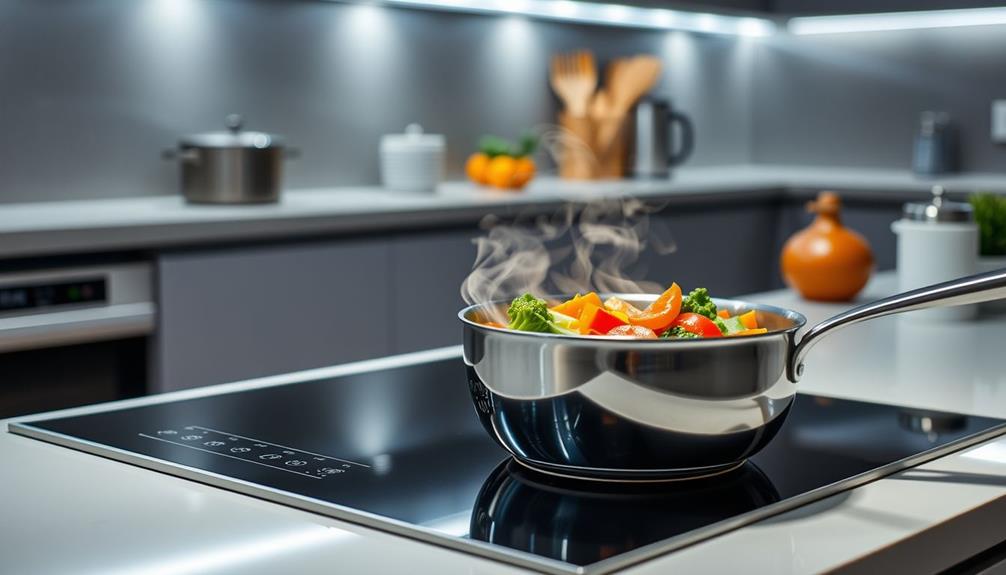
When you switch to induction cooktops, you'll notice a remarkable boost in energy efficiency, saving you money on your energy bills.
Not only do they use energy more effectively than gas stoves, but they also promote better indoor air quality by eliminating harmful emissions.
Additionally, these cooktops operate with minimal heat loss, similar to the thermal energy transfer basics of heat pumps, further enhancing their efficiency.
Plus, the faster cooking times mean you can whip up meals in no time, making your kitchen experience even better.
Energy Efficiency Comparison
Experience the remarkable energy efficiency of induction cooktops, which operate at about 84% efficiency—far surpassing the mere 40% efficiency of gas cooktops. This means you'll waste less energy while cooking, making your meals quicker and more cost-effective.
Additionally, the shift towards more energy-efficient appliances aligns with the trend of sustainable technology innovations that aim to reduce environmental impact.
Here are some benefits of choosing induction cooktops:
- Faster Cooking: Water boils in about 5.8 seconds, compared to 8.3 seconds on gas.
- Lower Energy Bills: The high energy efficiency translates to reduced energy consumption.
- Less Wasted Energy: Induction cooktops lose only 16% of energy, unlike gas stoves that lose around 60%.
- Healthier Air Quality: Induction cooking eliminates combustion emissions, reducing indoor air pollution and respiratory risks.
- Sustainable Choice: You'll decrease reliance on fossil fuels, promoting a more eco-friendly lifestyle.
Environmental Impact Benefits
Induction cooktops offer considerable environmental impact benefits that make them a smart choice for eco-conscious consumers. By opting for induction cooking, you can achieve up to three times more energy-efficient performance compared to gas stoves. This not only lowers your household energy consumption but also greatly cuts down on carbon dioxide emissions.
For instance, boiling water with natural gas releases about 1.16 lbs of CO2, while induction cooking produces only 0.29 lbs, showcasing a remarkable reduction in greenhouse gas impact. Additionally, adopting a holistic lifestyle approach can complement the environmental benefits of induction cooking, as it promotes sustainable practices that benefit both the home and the planet.
Moreover, induction cooktops help decrease indoor air pollutants. Gas stoves emit harmful emissions that can lead to respiratory problems, including childhood asthma. With induction cooking, you eliminate these risks, creating a cleaner cooking environment.
Plus, since induction technology prevents burnt overspills, it contributes to better indoor air quality. Transitioning to induction cooking means you can also leverage renewable energy sources, further enhancing sustainability.
You're not relying on fossil fuels like natural gas, making your cooking habits more eco-friendly. Choosing induction cooktops is a proactive step towards a healthier home and planet.
Gas Cooktops Overview
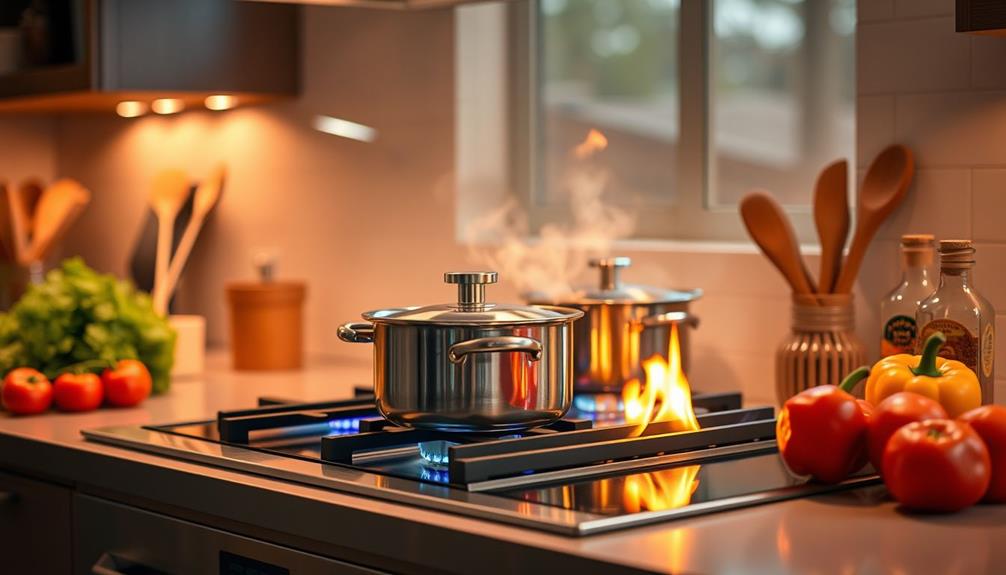
Gas cooktops are a popular choice among home cooks due to their ability to provide instant heat and precise flame control. These cooktops rely on natural gas or propane, ignited by a spark to produce an open flame that heats your cookware directly.
While they offer several benefits, such as perfecting espresso with quick temperature adjustments for brewing, it's important to take into account their efficiency and maintenance needs.
- Instant heat for quick cooking
- Precise flame control for versatile meals
- Compatibility with various cookware materials
- Open flame for effective browning and charring
- Regular maintenance to keep grates and burners clean
However, gas cooktops typically have an efficiency rating of around 40%, meaning about 60% of the energy is lost during cooking.
You can use all types of cookware, from aluminum to glass, enhancing your cooking flexibility.
Keep in mind that maintenance can be more time-consuming, as you'll need to clean the grates and burners regularly.
Environmental Impact of Cooking

The choice of cooking appliances not only affects your culinary experience but also has considerable environmental implications. When you opt for induction cooktops, you're choosing an energy-efficient option that can drastically reduce your carbon footprint. With about 85% energy efficiency, induction cooking saves over 1,000 GWh of energy annually in the U.S., helping to lessen reliance on fossil fuels and lower household greenhouse gas emissions.
Furthermore, the unique interplay of sound waves and light in phenomena like sonoluminescence underscores the importance of energy conversion, which is similarly reflected in the efficiency of induction cooking.
In contrast, gas stoves only achieve around 32% efficiency, leading to substantial energy loss and higher emissions. Natural gas emits 1.16 lbs CO2 for cooking, while induction produces just 0.29 lbs CO2 when boiling water. This stark difference highlights the environmental benefits of induction cooking.
Additionally, induction cooktops produce no combustion emissions, which greatly improves indoor air quality. Gas stoves, however, have been linked to harmful pollutants that can exacerbate respiratory issues, including childhood asthma.
As concerns about climate change and air quality grow, many states are considering regulations to phase out gas stoves in favor of more sustainable alternatives. By choosing induction, you contribute to a healthier environment for yourself and future generations.
User Experiences With Induction
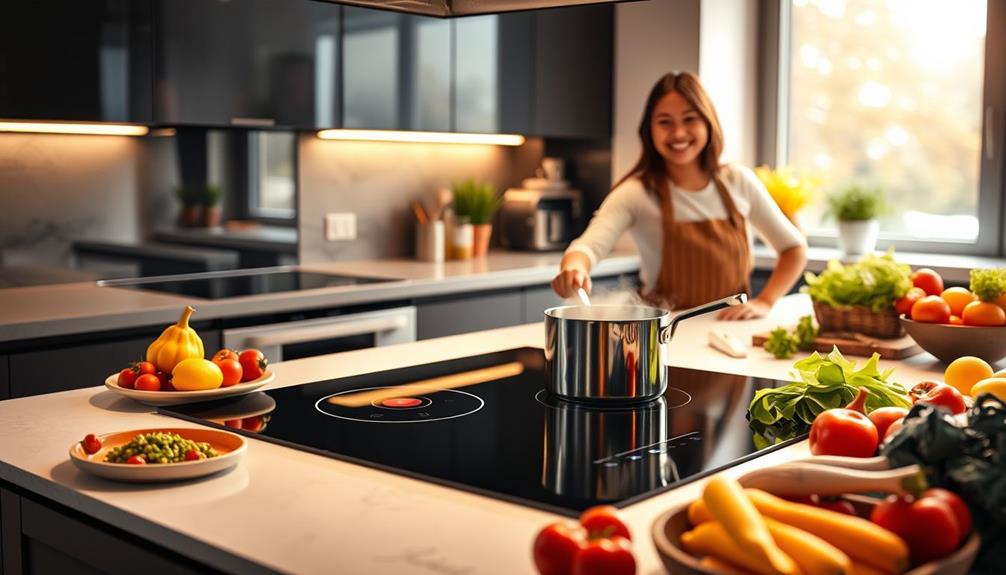
Many home cooks are discovering the benefits of induction cooktops, often praising their speed and efficiency in the kitchen. Users love how induction heating can cook food 20-40% faster than traditional gas stoves, making meal prep a breeze.
The quick heating also allows for more precise temperature control, which is essential for achieving the perfect results in cooking. Plus, the smooth glass surfaces of induction cooktops make cleaning a simple wipe-down, unlike the crevices found in gas models.
For those interested in maintaining a clean home, it's worth considering the essential items for a home cleaning kit.
Here are some highlights from user experiences:
- Energy Efficient: Induction cooktops use less energy than gas, saving you money on utility bills.
- Healthier Cooking Environment: Induction eliminates indoor air pollution associated with gas stoves, reducing respiratory issues.
- Adaptable Cookware: While you may need to invest in induction-compatible cookware, many find the change easy.
- Quick Cooking: Enjoy faster meal preparation, perfect for busy weeknights or entertaining guests.
- Safety Features: Induction cooktops remain cooler to the touch when not in use, providing peace of mind.
Cost Considerations
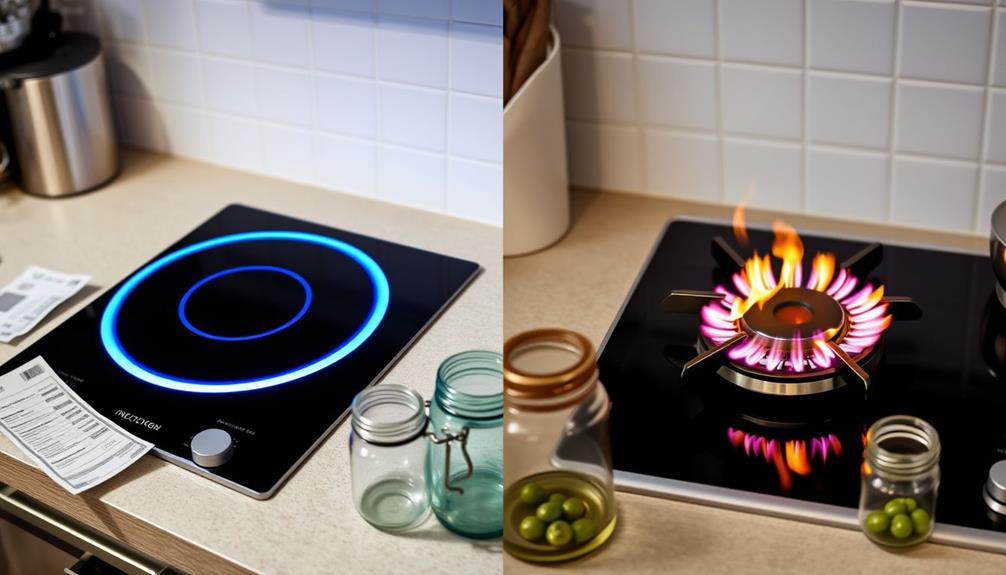
When you're weighing your options between induction and gas cooktops, cost is a key factor.
While induction models usually have a higher initial purchase price, they can save you money on energy bills over time.
Plus, consider how each type might impact your home's resale value, especially if buyers are looking for energy-efficient features.
Initial Purchase Price
Taking into account the initial purchase price is essential when choosing between induction and gas cooktops. You'll find that induction cooktops generally range from $900 to $1,900, considerably pricier upfront compared to gas cooktops, which can start as low as $290. High-end induction models can even reach $2,500, while advanced gas cooktops can match those prices.
Here are some key points to take into account:
- Induction cooktops boast energy efficiency rates of about 85%.
- Gas cooktops have lower efficiency, averaging around 32%.
- The Inflation Reduction Act offers rebates up to $840 for induction appliances.
- Gas cooktops may incur higher operational costs over time due to fuel expenses.
- The initial purchase price of induction cooktops can be offset by potential savings.
While the initial purchase price of induction cooktops is higher, the potential for long-term savings on your energy bills can make them a smart investment.
Balancing the upfront costs and the benefits associated with energy efficiency can guide you in making the best choice for your cooking needs.
Long-Term Savings Potential
Long-term savings potential with induction cooktops can greatly impact your overall energy costs. By switching to induction cooking, you could experience significant reductions in utility costs. Induction cooktops are up to three times more energy-efficient than gas stoves, averaging around 84% efficiency compared to about 40% for gas. This difference can lead to noticeable savings on your energy bills over time.
Additionally, the Inflation Reduction Act offers rebates of up to $840 for those making the switch, further enhancing your long-term savings. With the increasing affordability of induction cooktops—starting around $1,000 for models and as low as $70 for single-burner options for renters—it's easier than ever to adopt this energy-efficient cooking method.
| Aspect | Induction Cooking | Gas Stoves |
|---|---|---|
| Energy Efficiency (%) | 84% | 40% |
| Average Cost of Cooktop | $1,000 | Varies; typically higher |
| Potential Rebates Available | Up to $840 | None |
Resale Value Impact
Switching to an induction cooktop not only offers immediate energy savings but can also enhance your home's resale value. As more buyers prioritize energy-efficient appliances, an induction cooktop may give your property a competitive edge in the market.
- Attracts environmentally conscious buyers
- Reduces energy costs and improves indoor air quality
- Ranges from $1,000 to $2,500, appealing to modern tastes
- May deter buyers due to higher operational costs of gas cooktops
- Increases demand in energy-efficient markets
While gas cooktops typically have a lower upfront cost (between $300 and $1,500), they often lead to higher operational costs, which could be a red flag for some buyers.
Homes equipped with induction cooktops are increasingly sought after as they represent a commitment to sustainability and modern living.
Ultimately, the resale value impact of your choice can depend on your local real estate market and buyer preferences.
If you aim to appeal to eco-conscious consumers and those looking for energy-efficient solutions, investing in an induction cooktop could pay off considerably when it's time to sell your home.
Maintenance and Care
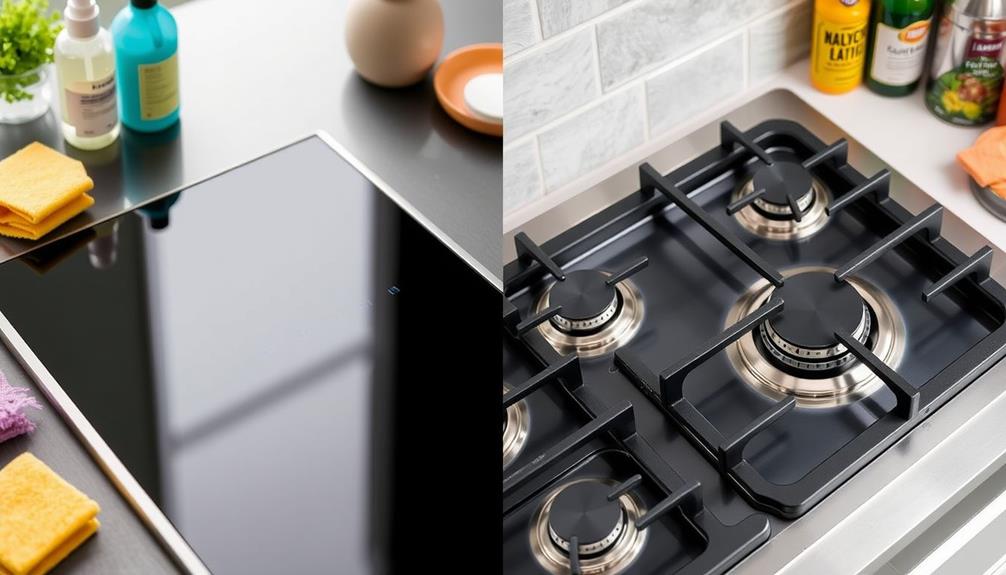
When it comes to maintenance and care, induction cooktops are generally simpler and more efficient to clean than gas cooktops. Their smooth glass surface makes cleaning a breeze. Spills don't burn onto the surface, so you can often wipe them up with a vinegar and baking soda solution. You won't have to worry about scrubbing as hard as you'd with gas cooktops.
In contrast, gas cooktops require more effort. Cleaning involves disassembling grates and drip pans for thorough maintenance. The grooves around burners can trap food and grease, making it a more time-consuming task. Regular maintenance for gas cooktops may include soaking grates and using nylon brushes to tackle stubborn stains, while induction cooktops only need simple surface wipes.
Additionally, the glass top of induction cooktops is designed to be crack-resistant, reducing the risk of damage during cleaning. This durability adds to the appeal of induction cooktops, making them a practical choice for those who want an efficient cooking experience without the hassle of frequent, extensive cleaning.
Transitioning to Induction

Considering the numerous benefits, shifting to induction cooking offers a compelling alternative to traditional gas stoves. By making this change, you can enjoy significant advantages, including:
- Energy savings: Induction cooktops are up to 3 times more efficient than gas stoves.
- Faster cooking: Reduce cooking time by 20-40% thanks to direct heat through electromagnetic energy.
- Healthier home: Improve indoor air quality by eliminating harmful pollutants associated with gas cooking.
- Financial incentives: Take advantage of potential rebates up to $840 under the Inflation Reduction Act.
- Future-ready: Many states are encouraging a move away from gas appliances, making induction a smart choice for new installations.
Switching to induction cooktops not only enhances your cooking experience but also contributes to energy savings and a healthier environment.
As you consider this option, remember that the initial costs can be offset by available financial incentives.
With more efficiency, better indoor air quality, and the potential for savings, it's clear that moving to induction is a wise decision for both your kitchen and your well-being.
Final Thoughts on Efficiency

Induction cooking stands out not just for its modern appeal but also for its remarkable efficiency. When you compare induction models to gas stoves, the difference in energy efficiency is striking. Induction cooktops achieve approximately 84% efficiency, while gas stoves hover around just 40%. This means you're losing about 60% of the energy with gas, whereas induction minimizes energy loss to around 16%.
If you're looking for speed, induction cooking boils water in about 5.8 seconds, notably quicker than the 8.3 seconds it takes with gas. This efficiency not only saves you time but also translates into considerable energy savings over the long run. In fact, changing to induction could save the U.S. over 1,000 GWh annually, highlighting its energy-efficient potential.
Moreover, induction cooking offers health benefits by reducing indoor pollutants linked to respiratory issues, making it a healthier choice for your indoor air quality.
If you value efficiency and health in your kitchen, switching to induction cooktops is a smart move. You'll enjoy faster cooking times, lower energy bills, and a cleaner environment all at once.
Frequently Asked Questions
Is an Induction Cooktop Cheaper to Run Than Gas?
Yes, an induction cooktop's generally cheaper to run than gas. With higher energy efficiency, quicker cooking times, and fewer health-related costs, you'll likely save money over time by choosing induction over gas.
What Is the Downside of Induction Stoves?
Induction stoves can be pricey upfront, require specific cookware, and might hum at higher settings. You'll also need to take into account potential electrician costs for installation and the hassle of using analog thermometers for precise cooking.
Do Induction Cooktops Use More Electricity?
Induction cooktops don't use more electricity; they use it more efficiently. They convert energy into heat faster, cook quicker, and often lead to lower electricity bills. You'll save energy while enjoying faster meal preparation.
What Is the Most Energy-Efficient Cooktop?
When considering energy efficiency in cooktops, you'll find that induction cooktops stand out, achieving around 84% efficiency. They heat faster and reduce energy waste, making them the best option for eco-conscious cooking.
Conclusion
In the kitchen, your cooktop is the heart, pumping energy into every meal. Choosing induction is like opting for a swift river, flowing efficiently and leaving minimal waste in its wake. Gas, while familiar, resembles a flickering candle, warm but less controlled. As you weigh your options, imagine the vibrant feast you could create with the steady pulse of induction, lighting up your culinary journey while nurturing the planet. Efficiency isn't just a choice; it's the spark that ignites your cooking.










